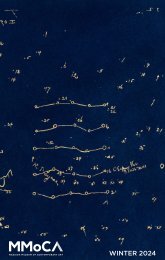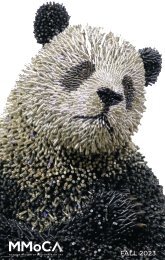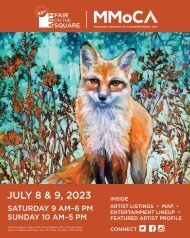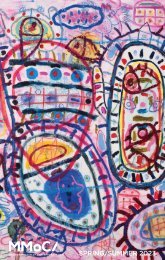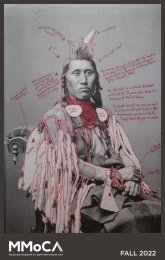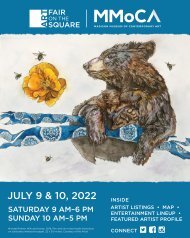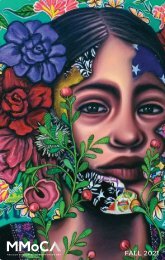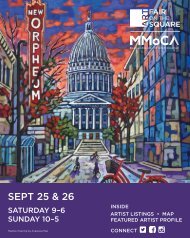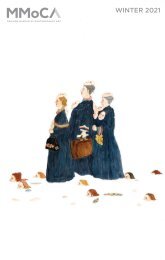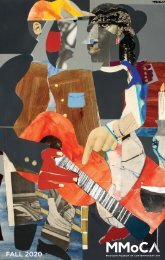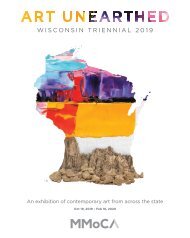MMoCA Winter 2020 newsletter
Exhibitions of the Chicago Imagists, James Cagle, and Ray Yoshida. Jasper Johns in our collection.
Exhibitions of the Chicago Imagists, James Cagle, and Ray Yoshida. Jasper Johns in our collection.
You also want an ePaper? Increase the reach of your titles
YUMPU automatically turns print PDFs into web optimized ePapers that Google loves.
EXHIBITIONS & NEWS<br />
JAMES CAGLE<br />
Excavation<br />
Imprint Gallery • Feb 29–May 24<br />
James Cagle’s 1974 film, Excavation,<br />
accompanies the artist’s larger photographic<br />
exhibition on view in the museum’s<br />
State Street Gallery. As with his<br />
photographs, Cagle’s films demonstrate<br />
his interest in formalism, an approach to<br />
filmmaking that emphasizes the physical<br />
properties of film as a material, rather than<br />
film as a narrative tool. Formalist explorations<br />
in film typically involve experiments<br />
with sound, light and exposure, time and<br />
movement, shot composition, editing, and<br />
the varied ways in which all of these qualities<br />
can operate together on screen.<br />
Cagle plays with each of these elements in<br />
Excavation. He floods the viewer with a deluge<br />
of sensory information—rapid editing, superimposed frames, flashing imagery, accelerated zooming, and rhythmic<br />
sound. Visually fragmented, yet unified by recurring motifs, the film surveys the artist’s external landscape—rocks<br />
and canyons, trees, the female body, pointing fingers, etc.—as a means to hint at his interior mindscape. The pulsating,<br />
exhilarating soundtrack drives the film forward, complementing the cadence of the visuals. In creating this film,<br />
Cagle not only “excavates” the private workings of his inner world, but also the material components of filmmaking.<br />
RAY YOSHIDA<br />
The Spaces in Between<br />
Henry Street Gallery • On view through April 12<br />
Ray Yoshida: The Spaces in Between is a comprehensive look at the talented Chicago-based artist known for his experimental<br />
and innovative works of art. In a series of paintings from the 1970s, Yoshida depicted a set of abstract shapes<br />
that evoke just the sort of visual investigation that he strove to elicit: are they figures, tools, land formations? In Untitled,<br />
geometric structures appear to bulge and sprout appendages amid a background scattered with patches and dots of<br />
color. When asked about the patterning and its algae-like formations, Yoshida remarked that he was very interested<br />
in “the concept of conscious and unconscious... I don’t know if whether you have ever experienced sort of taking a nap<br />
or lying in the afternoon...with your eyes closed and seeing sort of these forms floating.” This allusion to the optical<br />
science of perception, together with the painting’s stippled patterning, is grounded in Yoshida’s fascination with the Neo-<br />
Impressionist artist Georges Seurat. He regularly walked by the artist’s pointillist masterpiece A Sunday on La Grande<br />
Jatte—1884 on display at the Art Institute of Chicago. In particular, Yoshida was intrigued by “the frozen quality” of<br />
Seurat’s figures, which mirror the rigid bodies in his own<br />
paintings. Yoshida’s patterning also nods to Seurat’s use<br />
of pointillism, but as a master of reinvention, he creates<br />
his own form of pointillism. While the technique of pointillism<br />
is the application of small dots to the surface of the<br />
painting, Yoshida’s technique is the inverse—Yoshida lays<br />
down a color for the ground of the painting, in this case a<br />
bright white, then paints on top of this base layer, carefully<br />
generating small windows for the white to peek through.<br />
While the collection of objects in this painting hover in<br />
a flotsam of marks, it remains a cohesive and rhythmic<br />
group that delights the eye and intrigues the mind.<br />
Exhibitions in the Henry Street Gallery are generously<br />
funded through an endowment established by the Pleasant<br />
T. Rowland Foundation.<br />
4






